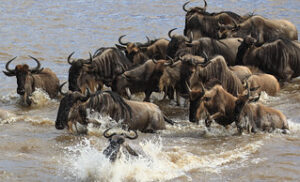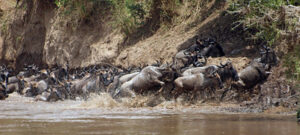Serengeti national park in Tanzania northern circuit is one of the most renowned wildlife destinations all over the world. This unique ecosystem with the diversified flora and fauna with the wildebeest migration the highlight of any African vacation safari to Serengeti. As we are approaching the end of the year, we have decided to look at one of the most famous activities in Serengeti that happen at the beginning of every year in Ndutu conservation are (southern serengeti) and some area of Ngorongoro conservation area. This event is the calving season that run from January through to march.
This period marks the beginning of great wildebeest migration that run throughout the year between the two neighboring countries of east Africa. That is Tanzania and Kenya. This period is the period of renewal and survival which explain the unique life cycle of the inhabitants of Serengeti region.
Understanding the wildebeest migration cycle
Even though the Serengeti wildebeest migration is described with two distinct seasons, the migration is a year-round event with wildebeest together with other herbivore moving from south to the north searching for the green pastures. During the movement, the herbivores are usually closely followed by the big cats who feast on them. The movement of the wildebeest herds is majorly determined by the rainfall season. This so because the cause of movement is the search for greener, more nutritious vegetable.
It is believed that given a chance, wildebeest would choose to stay in the northern Serengeti due to the highly nutritious grazing in the area and short plains that improve their defensive mechanism against the predators
Expectation in Tanzania between December and April
It is not a coincidence that the herds of wildebeest flock the southern part of Serengeti in Ndutu conservation area and some parts of Ngorongoro conservation area to give birth. After the rainy season that happen between October and December the conservation area is full of green lush, full of nutrients. And it short savanna grassland makes easy for these wildebeests to be able to protect their newborn with in the abundancy of food for the newborn and the mothers to feast on.
This area is too fertile because of the volcano eruption that happened some time back that enriched the soil with a lot of minerals that can support the growth of green vegetation for the wildebeests and other herbivores to feast on.
Between April and may when there is a reduction in the amount of rainfall the southern Serengeti get, the herds of wildebeest and other herbivores start their journey to the north in search for the new grazing grounds. While moving to the north, they will be closely followed by the big cats like lions, leopard and cheetah that has been living with the wildebeest in Ndutu and Ngorongoro.
Why there is a lot of carnivores December and April in southern Serengeti?
The coming of cats to Ndutu conservation area and Ngorongoro conservation area is to feast on the newly born wildebeest and other herbivores like zebra. The newborns are very vulnerable and on a high risk of being hunted by these cats. Cats also use this opportunity of availability of a lot of vulnerable food to teach their young ones how to hunt in the wild.
Surely the young cats that are born during this time will gain a valuable experience through hunting the weak and vulnerable newborn herbivores. As the wildebeest together with other herbivores start moving to the north of Serengeti, of course even their masters, the cats will follow them closely to ensure that cat’s meat does not go very far away from them. If you are lucky enough, you will be able to witness a predator-prey interactions.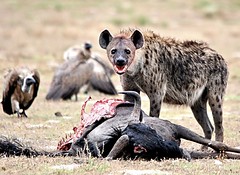
What to expect between July and October
By July, the wildebeest with other herbivores start attempting to cross the Mara river which will producing a thrilling view as wildebeest will be struggling for their lives against the waves of moving water and crocodiles that will be trying feast on them. The herbivores will cross the Mara river several times before settling in central Serengeti (in seronera region).
By November, the herds of wildebeest and other herbivores will start moving back to south Serengeti settling in Ngorongoro conservation area and Ndutu conservation area. And the circle will restart again.
With 4×4 Landcruiser cars you can visit Serengeti any time of the year and follow the migration as it moves in the circle.
The role of the ecosystem
The calving season is not only essential for the herbivores, but it is also essential for carnivores that feeds on the newborns. In the process of predators feeding on the newborn herbivores, they keep the population of wildebeest and other herbivores in check while they also ensuring their survival.
African safari packages to carry out during the calving season
[/vc_column_text][/vc_column][/vc_row]
10 Day Wildebeest and gorillas vacation safaris

Embark on a captivating journey through the heart of East Africa as we invite you to explore the enchanting landscapes, vibrant cultures, and rich biodiversity of Rwanda and Tanzania. This meticulously crafted 10-day itinerary promises an immersive experience, seamlessly blending the awe-inspiring encounters with gorillas
| TRIP DETAILS |
| REQUEST INFO |
6 Day Wildebeest and gorilla trekking safari
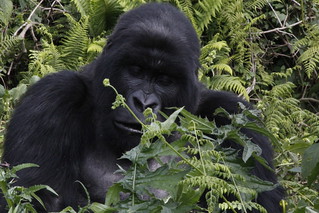
Book 6 Days Ngorongoro crater visit and Rwanda gorilla trekking to explore Tanzania & Rwanda on an Africa Safari experience tailored by Active African vacation the leading Safari operator in Uganda. The 6 Days Tanzania Rwanda Safari takes you to the great Ngorongoro crater reserve for an amazing wildlife experience.
| TRIP DETAILS |
| REQUEST INFO |
7 Day Rwanda-Tanzania vacation safari
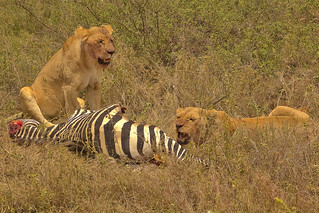
Depending on the degree of lodging, the time of year, and the particular parks and activities included a 7-day safari in Rwanda and Tanzania might have somewhat different costs. Along with activities to do in every park, below is a sample schedule including expected expenses for middle-class, budget, and luxury alternatives.
| TRIP DETAILS |
| REQUEST INFO |


